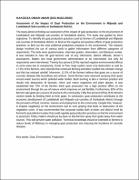| dc.description.abstract | KAKOOZA OMAR UMAR (2010-M152-20020)
Assessment of the Impact of Goat Production on the Environment in Mijwala and Lwebitakuli Sub-counties in Sembabule District.
The study aimed at finding out assessment of the impact of goat production on the environment of Lwebitakuli and Mijwala sub-counties of Sembabule district. The study was guided by three objectives: To identify the goat production practices used by farmers of Lwebitakuli and Mijwala sub-counties of Sembabule district, to find out the negative and positive effects of goat production practices, to find out the most preferred production practices in the environment. The research design involved the use of various tools to gather information from different categories of respondents. The tools were questionnaires, interview guides, observation, and literature review. It was intended to have 90 goat farmers and 15 key informants, district officials, farmer’s associations, leaders and local government administrators to be interviewed, but only 83 respondents were interviewed. Twenty four percent (24%) reported negative environmental effects in some areas due to overgrazing. Goats on free range system cause crop destruction as said by 17.5% of the farmers, who reported that continued farming activities resulted into climatic change and this has reduced rainfall. Moreover, 12.2% of the farmers believe that goats are a source of zoonotic diseases like brucellosis and anthrax. Some farmers were observed spraying their goats around water sources which polluted water bodies. Bush burning is also a common practice and results into destruction of biomass, micro and macro organisms and plant species. It was established that 73% of the farmers think goat production has a high positive effect on the environment through the use of manure which improves on soil fertility. Furthermore, 82% of the farmers said goats are a source of income to the community. Fifty five percent (55%) of the farmers control weeds by feeding them to their goats. In conclusion, goat production contributes to the economic development of Lwebitakuli and Mijwala sub-counties of Sembabule district through the provision of food, incomes, manure and employment to the community. Despite this, however, it impacts negatively on the environment due to over grazing that leads to destruction of the vegetation cover. It was recommended that corporate bodies both at lower and district level be formed to put policies in place that could regulate goat production practices so that the environment is preserved. Policy makers should put by-laws so that farmers spray their goats away from water sources. This will prevent water pollution. Technical knowledge should be extended to farmers to reduce levels of illiteracy in managing goat production and reducing the incidence of zoonotic diseases.
Key words: Goat, Environment, Production | en_US |


